


As shown in part one of the Marketing Analytics 2022: State of Play, manual data wrangling was the biggest challenge for marketers and marketing data analysts in 2021. From this challenge comes a sprawling mass of other issues, including lack of visibility, poor data accuracy, and a lack of actionable insights. In part two of the report, we explore how close to analytical maturity marketing teams truly are, and how these stumbling blocks could threaten marketing strategies for 2022.
On the surface, marketers and analysts are optimistic about their analytical maturity, with two-thirds identifying as analytically mature. However, digging deeper, we find their actual capabilities are much less advanced than we’d expect from an analytically mature organization. In reality, the majority of marketing departments rely on outdated data and analytics practices.
For instance, 68% of respondents who strongly identify as analytically mature say their marketing reports are typically built on spreadsheets. Likewise, 77% of respondents who strongly identify as analytically mature say they have yet to achieve a single, unified view of marketing performance. Marketing teams are living in the past when it comes to data and analytics.
Marketing teams see the value of predictive analytics with almost two-thirds planning to implement predictive modeling in 2022. Marketing is reaching a tipping point as teams aim to take campaign optimization from reactive to proactive. Similarly, 56% of marketers and analysts plan to implement marketing mix modeling in the coming year. Both these strategies require accurate, integrated data, and neither can be achieved in a meaningful way without a certain level of analytical maturity. However, far too often marketing teams still rely heavily on manual data processes to get insights from data.
Marketers and analysts have widely varying views on what technology they need, and even what they already have access to. 60% of analysts say they can run predictive analytics, but only 42% of marketers agree. A cultural shift must take place so that advanced tech doesn’t gather dust, either because manual data integration undermines quality and eats up the time of the analyst, or because marketers don’t have an advanced enough understanding to use the tech at hand to get value from their data.
Marketers say they have plenty of data, but they don’t have a single place where they can see a full picture of their world. Subsequently, marketers’ top data priority for 2022 is to implement a single unified view of marketing data, with 58% saying this will happen in the next 12 months. The fact that this is still a work in progress for so many organizations speaks volumes as to how advanced marketing teams are analytically speaking, particularly when we take into account that analysts appear to have jumped the gun by making predictive analytics their top priority for 2022 (69%).
Many organizations are employing data scientists and then filling up their time with mundane work like manually pulling together data from different sources. Not only does this undermine data quality, but it also means that analysts aren't able to use the advanced skills they were hired for. To be truly data-driven, businesses need to prioritize foundational data tools which automate integration before they sink time and money into more advanced tech like predictive analytics.
Unless marketers and analysts can take a more realistic view of their current capabilities and address the gaps in their foundation, then it’s unlikely that they’ll move the needle on predictive analytics.
The majority of marketing departments rely on outdated data and analytics practices. Despite this, a worrying number of businesses that see themselves as analytically mature, while still wrestling with some elementary challenges. For example, 68% of respondents who strongly identify as analytically mature say their marketing reports are typically built on spreadsheets, and 77% have yet to achieve a single unified view of all their marketing data. However, steps such as establishing a single source of truth and eliminating manual spreadsheet-based data analysis are fast becoming standard practice for modern marketing departments. Before you set out a strategy for 2022, it’s important to understand how advanced your current marketing analytics strategy is, and where the gaps are.

Analytical maturity is a long and ever-lengthening road, and it goes far beyond solving the data wrangling problem. The most analytically mature marketing forces are able to uncover insights from data, measure the impacts of marketing decisions, and make better decisions based on data not just in real-time, but proactively.
This requires a good data culture, and it also requires the right tools to improve. Both are still challenges for many companies and marketing agencies. Two-thirds of respondents say that their marketing team is analytically mature, and 63% say they are data-driven.
But do our analytically mature respondents fit these criteria?
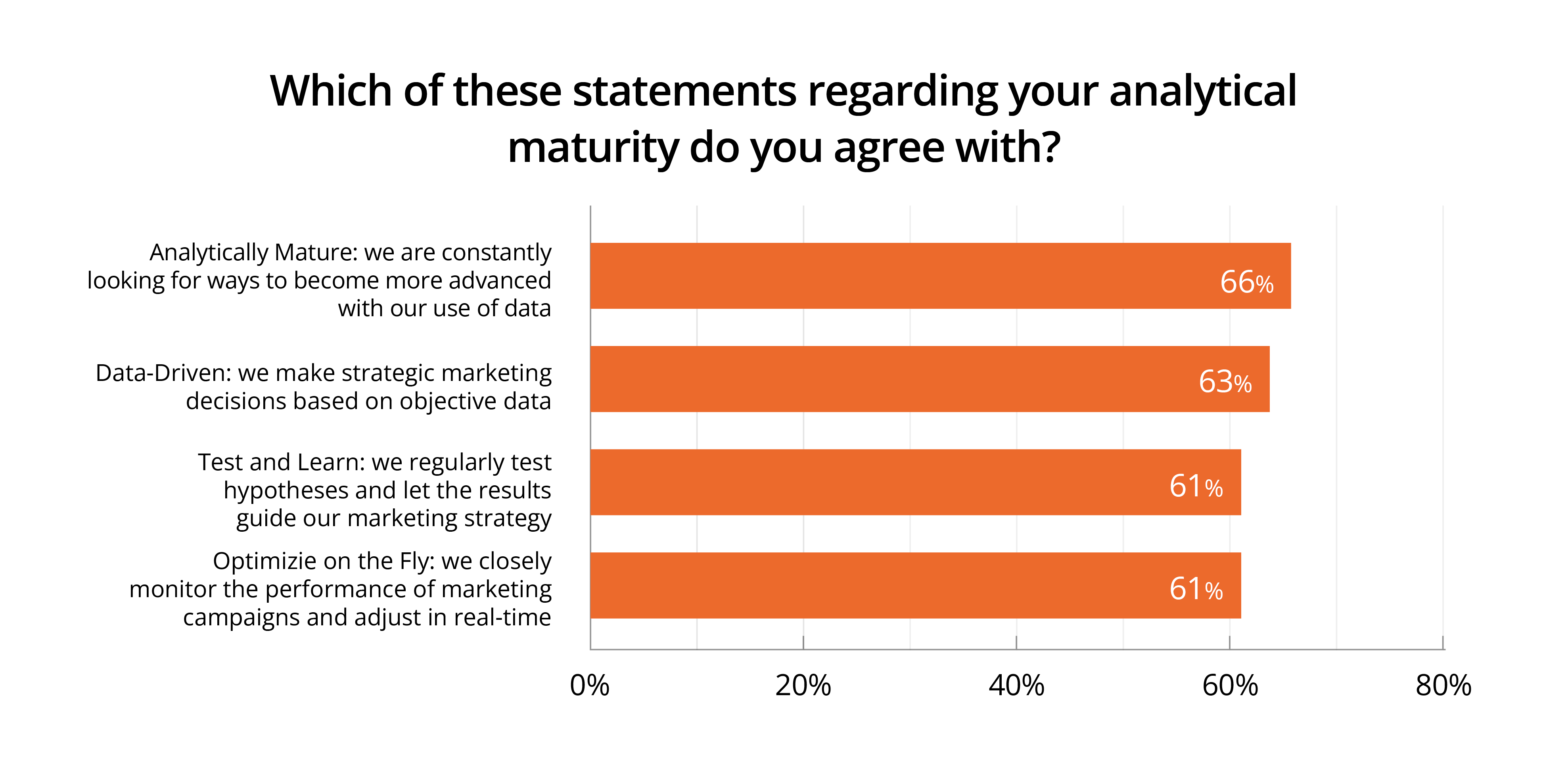
The current landscape of marketing sees many teams still grappling with manual data wrangling, and struggling to get a single unified view over their data. This tells us that among marketers and analysts, there is a widespread lack of awareness around what analytical maturity is, and how far teams still have to go to be truly data-driven.
Today, being analytically mature goes far beyond spreadsheets and manual number crunching. Marketing forces at the top of the data maturity curve are making decisions based on predictive insights, often powered by advanced AI. For these teams, automated data integration and a single unified view of marketing data are a given. However, more than three-quarters of marketers and analysts who say they’re data mature still haven’t taken this first step towards data maturity. Marketing teams need to take a critical look at their current capabilities. Before they consider advanced tech like predictive analytics, they must fill the gaps at their most basic level.
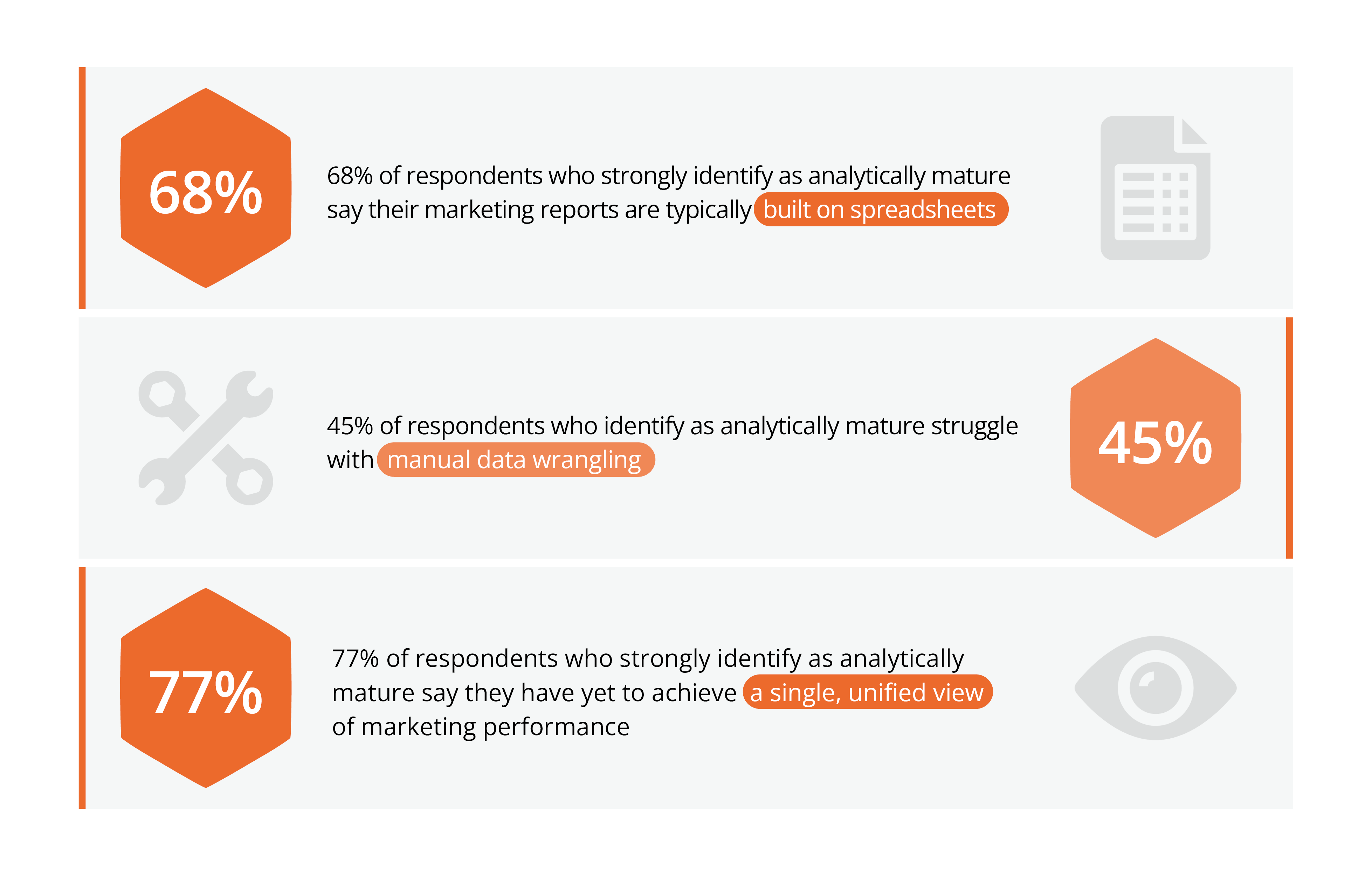
Data analysts (72%) are much more likely to self-identify as analytically mature than marketers (60%). While analysts are closer to the data and the tools used to gain insights from it, they have less of a view on how marketers are actually using data to drive decisions. So while analysts might have access to advanced analytics tools, this doesn’t translate into data maturity if marketers aren’t using these tools to turn data into actions.
And as we found in our full Marketers Vs. Analysts report, marketers often struggle to turn data into tangible insights.
63% of CMOs say they make decisions based on data, but more than half of those also say they lack data-driven insights to drive marketing strategy — and 49% lack data-driven recommendations to improve marketing performance.
Again, there seems to be a great deal of optimism when it comes to higher-level questions, but when we dig deeper, at a more operational and tactical level, the reality doesn’t seem to stack up.
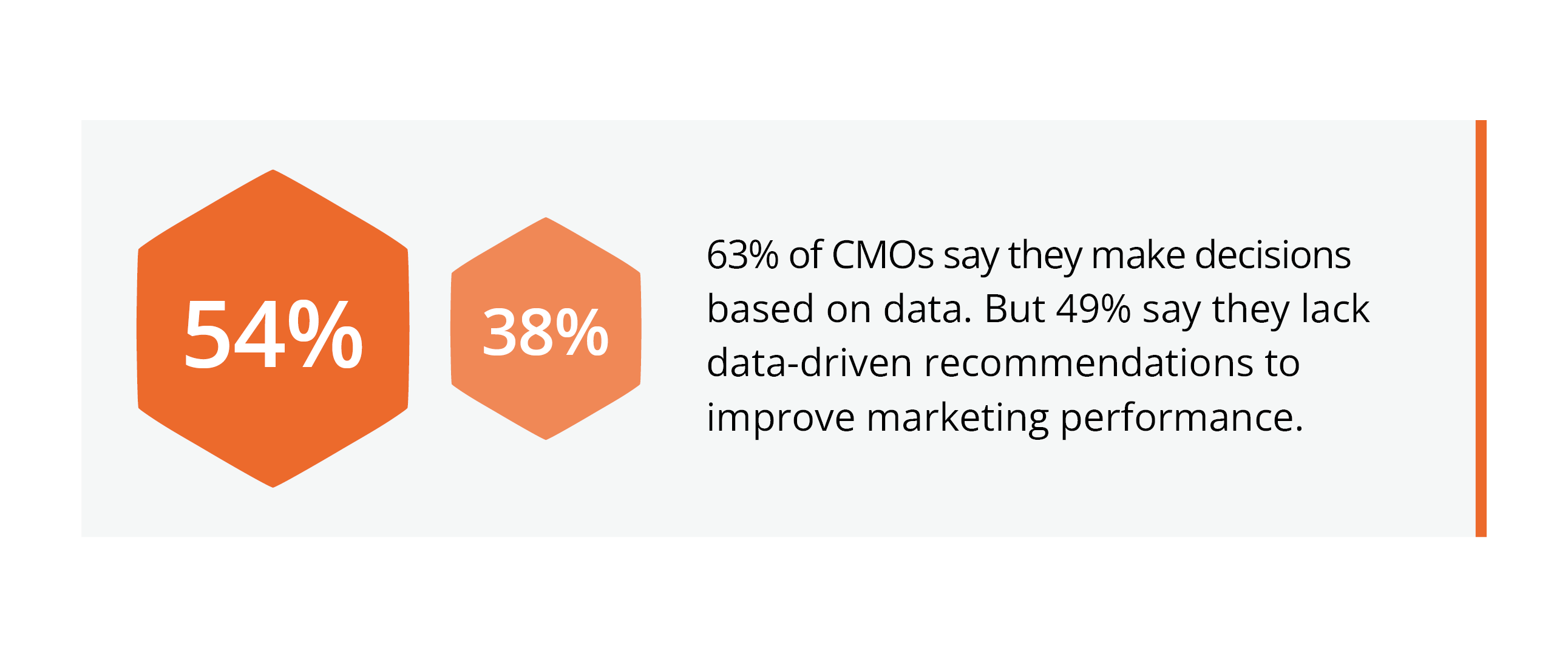
Data Analyst, USA, Specialist, Technology
The majority of marketers and analysts are still scrambling to gain a single view over all their marketing data, with 58% still building routine marketing reports on spreadsheets. Marketing teams understand that personalized content and predictive analytics will play a key role in building out a competitive advantage, but they don’t have the foundations to sustain this kind of tech yet. Until they face up to this, a proactive marketing strategy is off the table.
Shockingly, 58% of marketers and analysts say routine marketing reports are still built on spreadsheets. In part one of this research, our challenges and priorities report found that manual data wrangling is still a major stumbling block for marketing teams, and currently poses the most significant challenge. Marketers and analysts are still spending hours a week wrestling to get the same datasets in one place when this time could be much better spent getting value out of that data.
With 41% of analysts struggling to trust their marketing data, the number of manual processes the dataset goes through must be called into question. If data is being transferred from Facebook and LinkedIn to Excel and then into PowerPoint, this creates more cracks for human error to seep in.
Currently, 58% of respondents build reports manually on spreadsheets, and 65% manually transpose reports into PowerPoint or Google Slides. If marketing teams can automate these processes, they can save time by having an automated dashboard ready to present at a moment’s notice, while also avoiding the human error that comes with manual data wrangling.
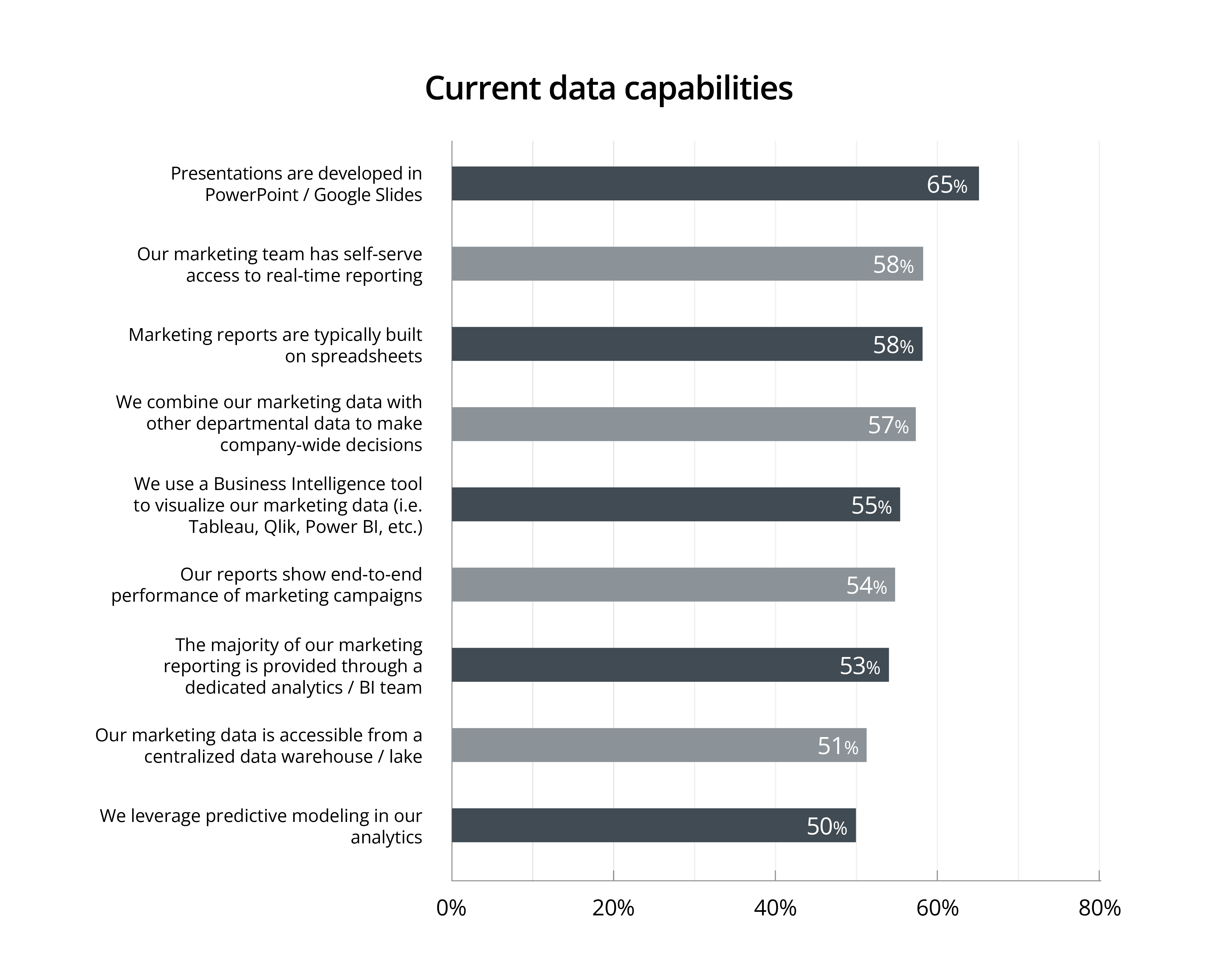
Only 51% of marketers and analysts say their marketing data is accessible from a centralized data lake. That means nearly half of marketing teams are still scrambling to create a full picture of their marketing performance with data from disparate sources.
And while more than half of respondents say that they have self-serve access to real-time reporting, 47% of these respondents also say manual data integration is a significant challenge. While the real-time data might exist, if it requires extensive manual work to make it usable, then it can’t be translated to real-time decisions.
Marketing teams are frustratingly close to having the data to drive effective decisions, but dependency on manual integration of these disparate data sources continues to hold them back.
Half of marketers and analysts say they are currently using predictive modeling in their analytics — and these respondents tend to have much stronger strategic capabilities bolstering their marketing strategy.
For example, marketing teams with strong campaign reporting capabilities are two times more likely to be using predictive analytics than those whose campaign reporting needs improvement. Likewise, those with strong campaign optimization are more than twice as likely to be using analytics.
On average, marketing teams who have strong strategic capabilities in a given area are 31% more likely to be using predictive analytics.
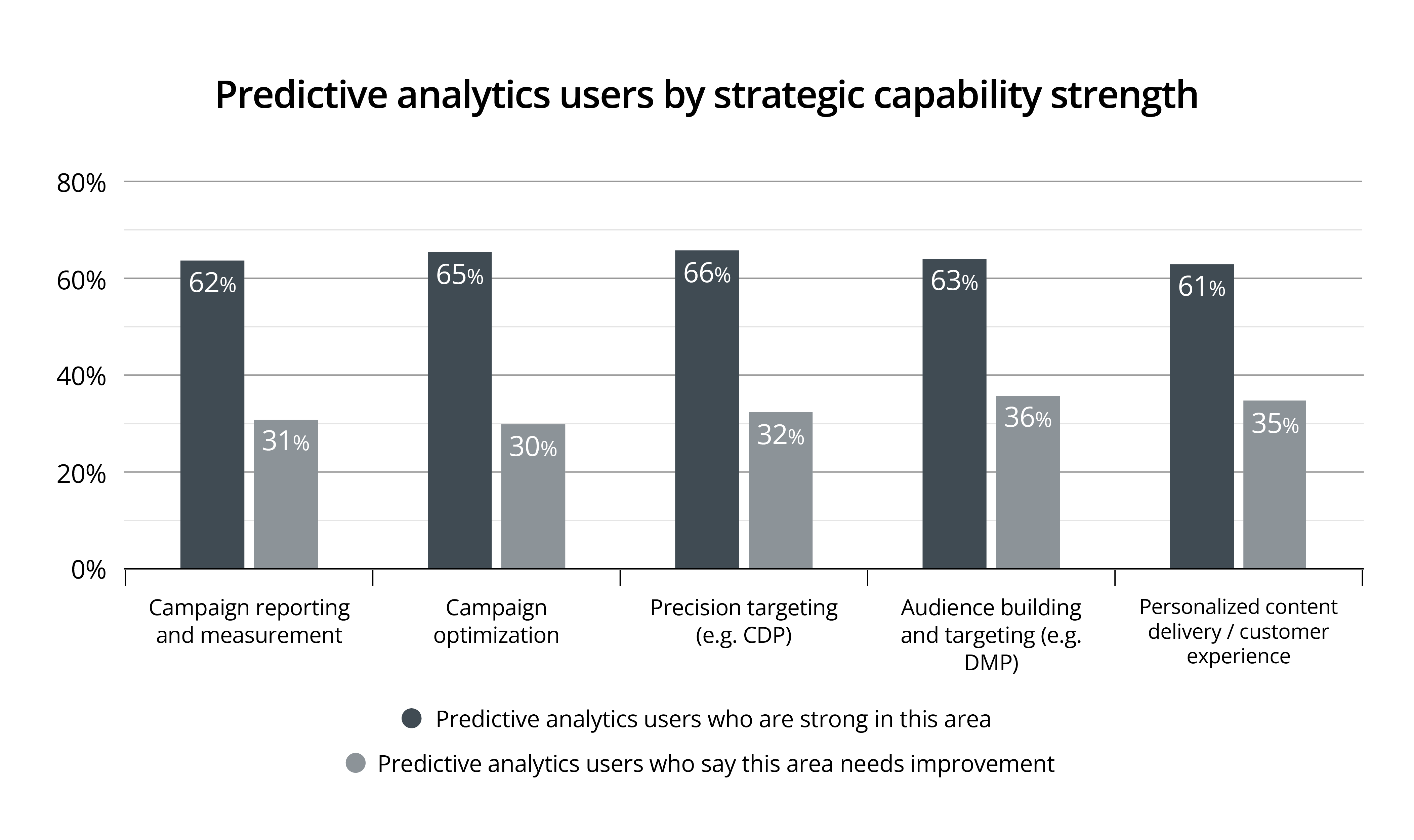
Marketing leaders understand the necessity of a proactive marketing strategy rather than a reactive strategy, but sustainable predictive modeling relies on a solid data infrastructure. Having all your data in one place is a prerequisite for predictive analytics. While it’s not impossible to do this manually, the amount of time and energy it takes to run just one of these models without automated data integration makes it unsustainable. Subsequently, marketers and analysts who have a higher adoption of more basic analytics tech are much more likely to be running predictive models.
Of those who have a central data lake 69% use predictive analytics — for those who don't this falls to 27%. Similarly, of the respondents who use a BI tool, 67% use predictive analytics, for those who don't this falls to 22%.
Data Analyst, USA, Specialist, Technology
The majority of respondents say they will achieve MMM and predictive modeling in 2022. While it’s promising to see the marketing industry understands the value of such technologies, we can’t ignore the groundwork that needs to be done. Manually inputting data into spreadsheets won’t cut it for predictive analytics, it takes too long to prepare, and causes too many errors. Marketing teams need a single view of marketing data which is automatically integrated.
61% of respondents say they plan to achieve more predictive modeling in 2022. While it’s promising to see that so many marketers and analysts understand the value of predictive analytics, there are still some major stumbling blocks to address before marketing teams can get value out of predictive analytics.
Predictive analytics is incredibly time intensive for those who still depend on manual data wrangling. However, 38% of respondents who plan to use predictive analytics say they still struggle with manual data wrangling, and 67% still use spreadsheets to build marketing reports.
What’s even more concerning is that 48% of analysts who plan to implement predictive analytics in the coming year say they struggle to trust their marketing data. This issue absolutely must be addressed before marketing teams sink time and money into predictive analytics — as the old adage goes, garbage in, garbage out. If your data isn’t accurate, the insights you get from it could end up doing more harm than good. However, marketers and analysts don’t appear to understand what groundwork must be done before predictive analytics can be seriously considered.
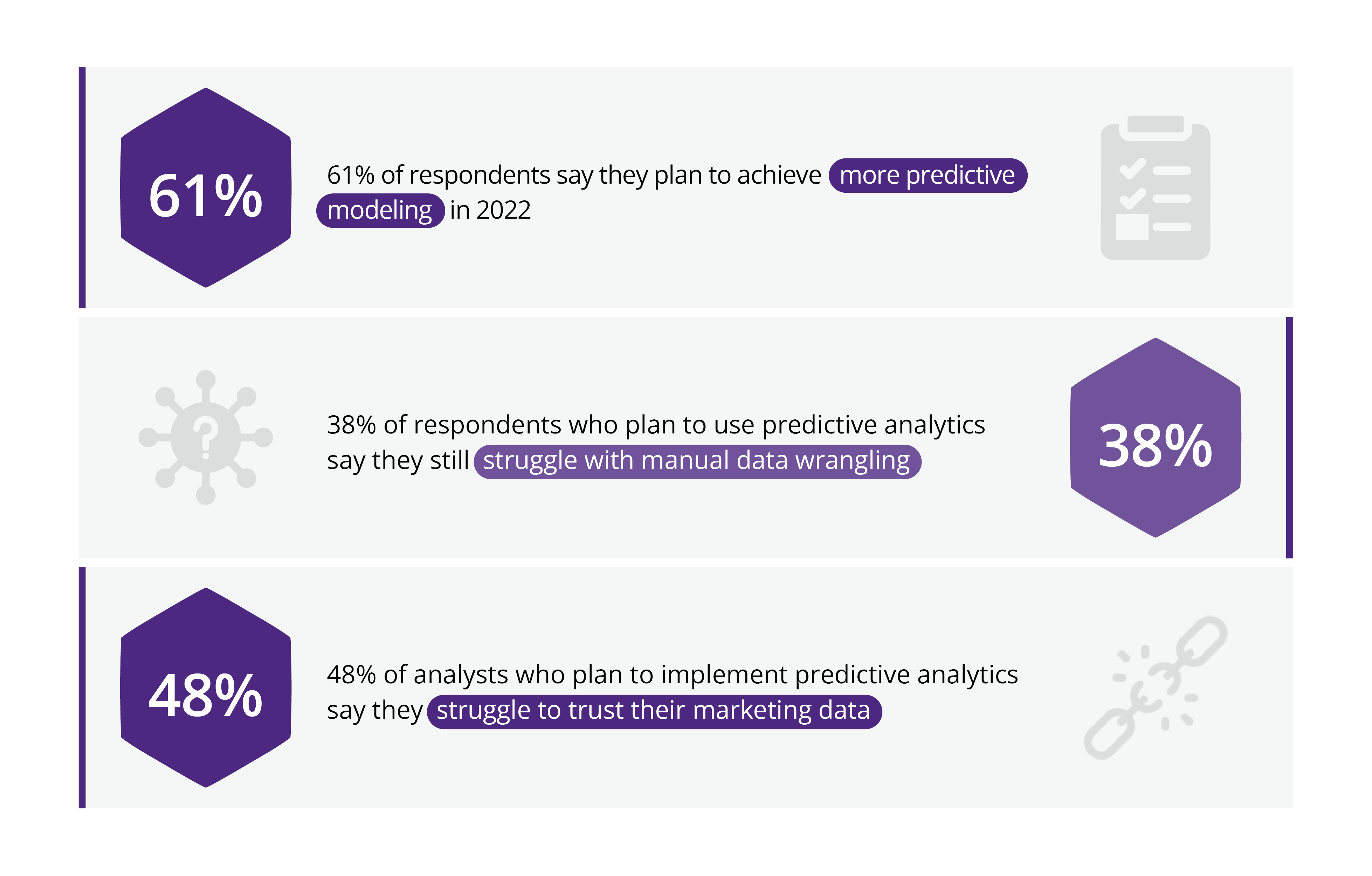
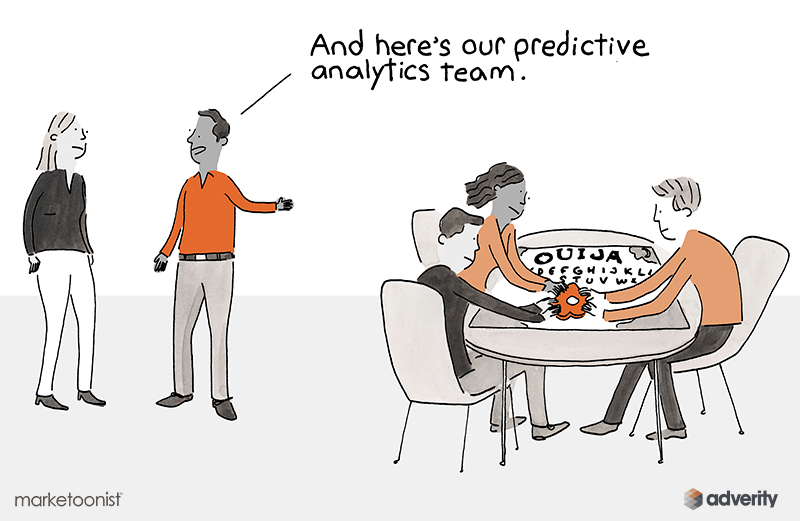
Data accuracy is often undermined by manual integration and the human errors that come with it. We can see a clear correlation here where respondents who have less trouble due to manual data integration also have higher trust in their data accuracy.
For analysts who don’t struggle with manual integration, only 15% say trust in data accuracy is a significant challenge, but for those who say manual integration is a challenge, this jumps to 63% who struggle with data trust. In other words, analysts who struggle with manual data integration are nearly four times as likely to struggle with low trust in data accuracy.
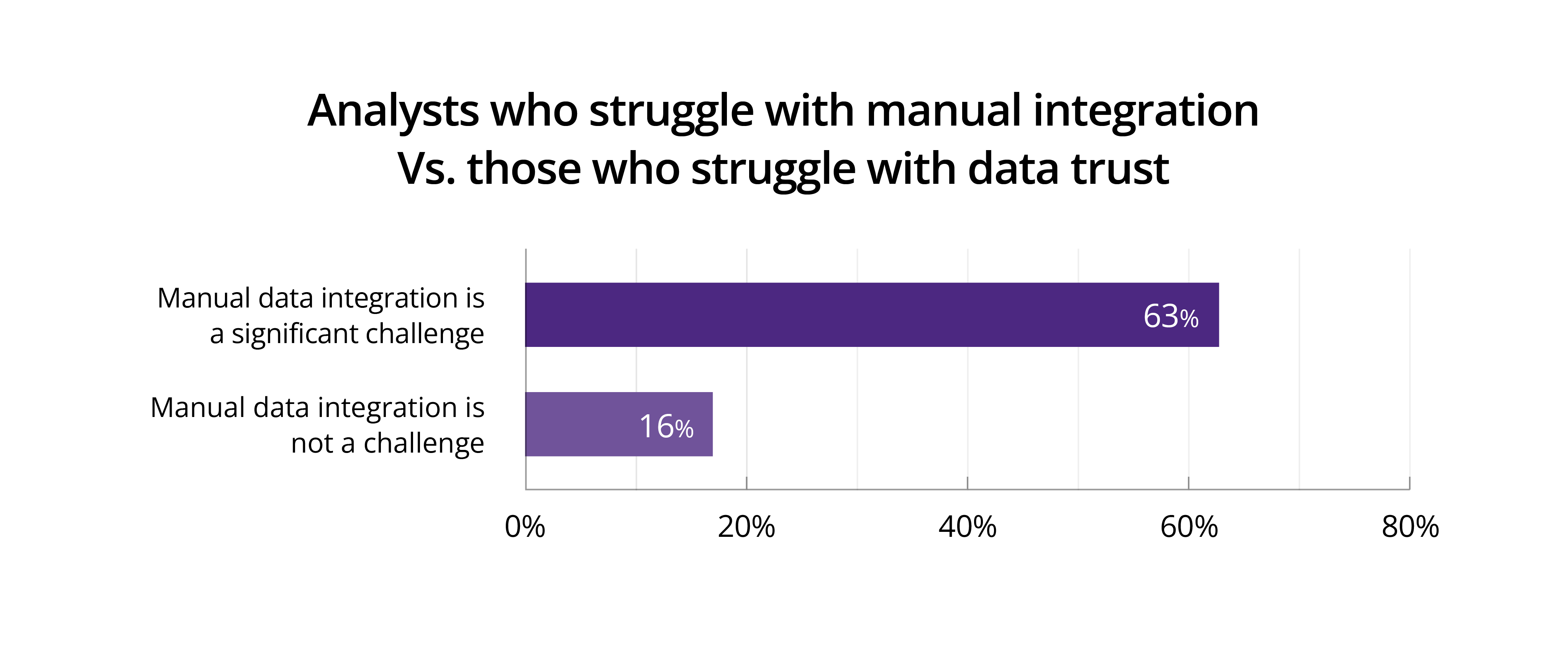
Before AI or predictive analytics can be sustainably implemented, marketing teams need a single unified view of their marketing data. 62% of respondents plan to achieve a single unified view of marketing data in 2022.
P&G, AT&T, Kraft, Coca-Cola, and Pepsi lead the way — but with cookie deprecation jeopardizing the multi-touch attribution model, marketing mix modeling (MMM) isn’t just for fortune 500 anymore. The majority of respondents say they intend to incorporate MMM into their marketing strategy in 2022.
Similarly to predictive analytics, marketing mix modeling algorithms can technically be done manually, but the amount of integration and manual wrangling this involves makes it unsustainable for those without automation.
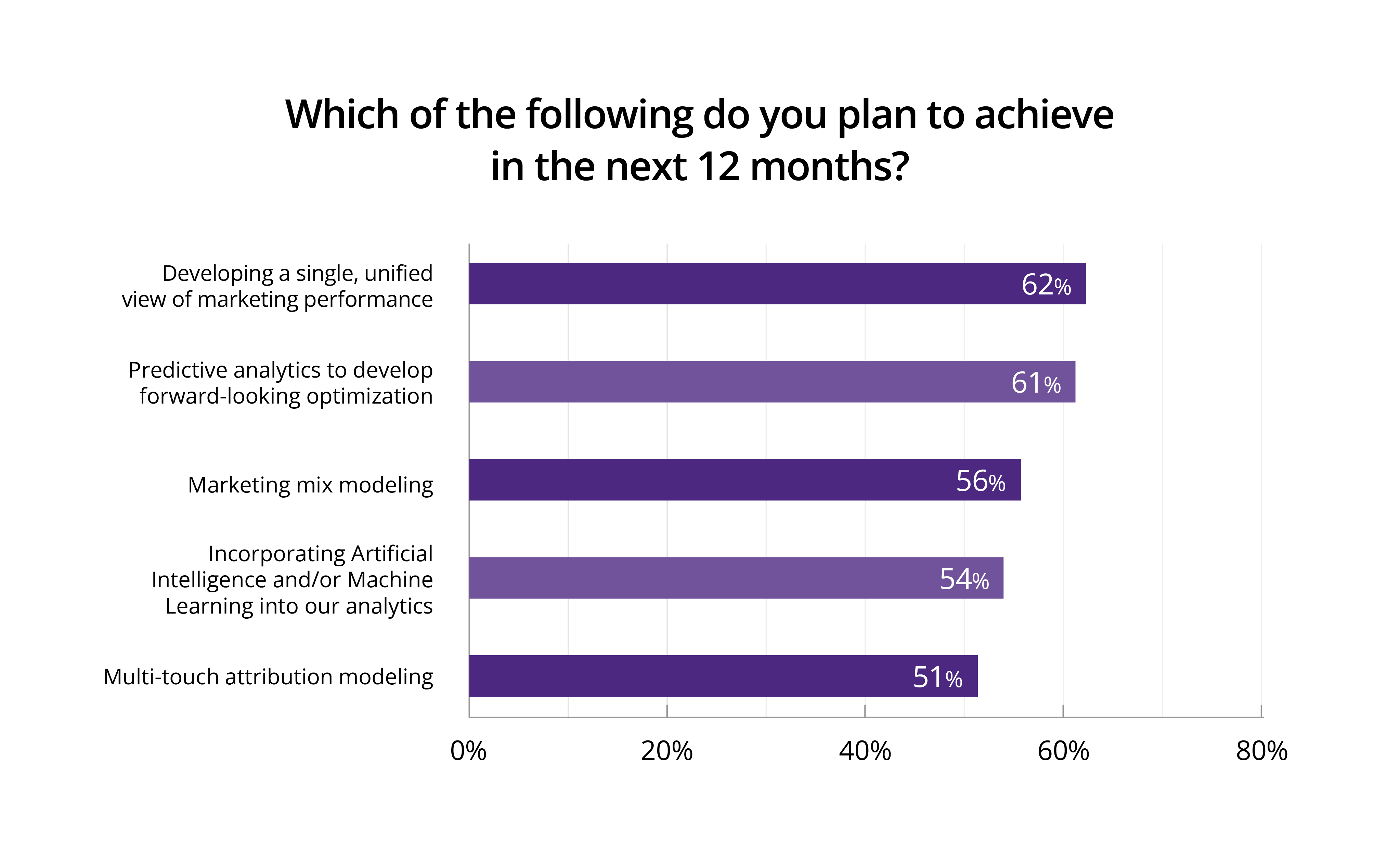
Data Analyst, USA, Director, Media and Entertainment
Marketers and analysts naturally have different priorities, but our data shows that this rift goes beyond just disagreeing on what marketing tech they want. Concerningly, marketers and analysts can’t even agree on what tech is already available to them. If marketers aren’t aware of the advanced tech in the analyst’s arsenal, then something’s gone seriously wrong. Whether it’s a problem with adoption, a miscommunication, or a lack of tools and time to get accurate data, all of these issues will continue to crop up and cause bigger problems as you add in more tech.
Only 3 in 5 analysts have access to a centralized data warehouse. This might explain why so much time is spent wrangling data — 41% of analysts still haven’t centralized their data. For marketers, the number jumps to 57% who don’t have a centralized view of their marketing data, and the fact that this number is so much higher may be symptomatic of the rift between analysts and marketers.
Marketers and analysts both most commonly state that presentations are developed in PowerPoint or Google Slides. However, when it comes to marketing reports, marketers say they build them in spreadsheets (56%), while analysts' second most selected capability is a BI tool to visualize their marketing data (64%).
Again, this is a worrying disconnect. BI tools and data dashboards offer a far more efficient, effective, and accurate method for marketing reporting than spreadsheets and PowerPoint. However, oftentimes marketers treat analytics as a black box — data goes in and insights come out. This means they might not be as aware of what tools are available to turn data into insights, or of how much work goes on behind the scenes on the part of the analyst.
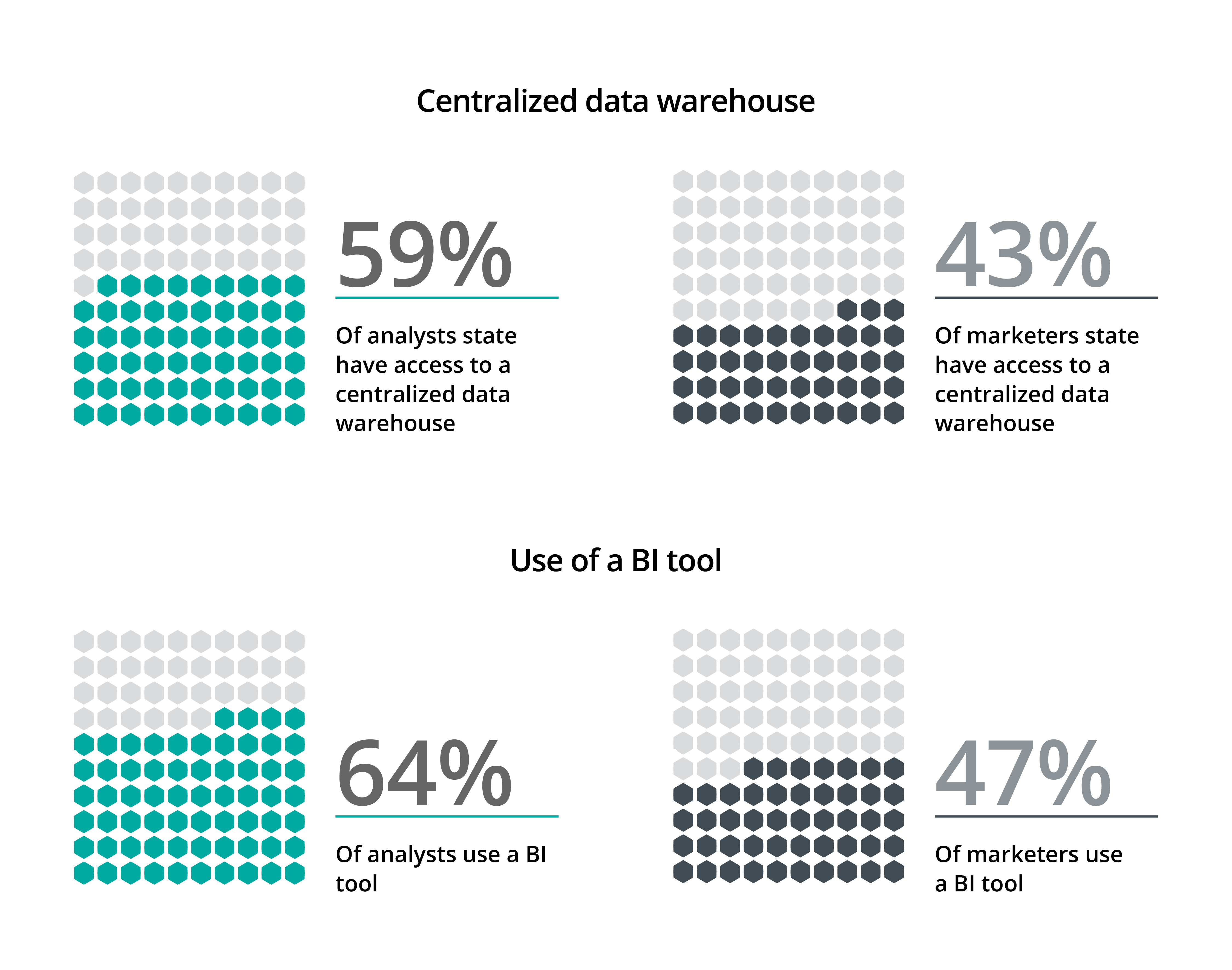
The gap between marketers’ and analysts’ reported capabilities is most prevalent for predictive analytics. While 60% of analysts say their organization has the capacity to run predictive models, only 42% of marketers say the same. While analysts might be trained and capable of running predictive models, it seems that analysts and marketers haven’t been able to agree on how predictive analytics can fit into their data strategy.
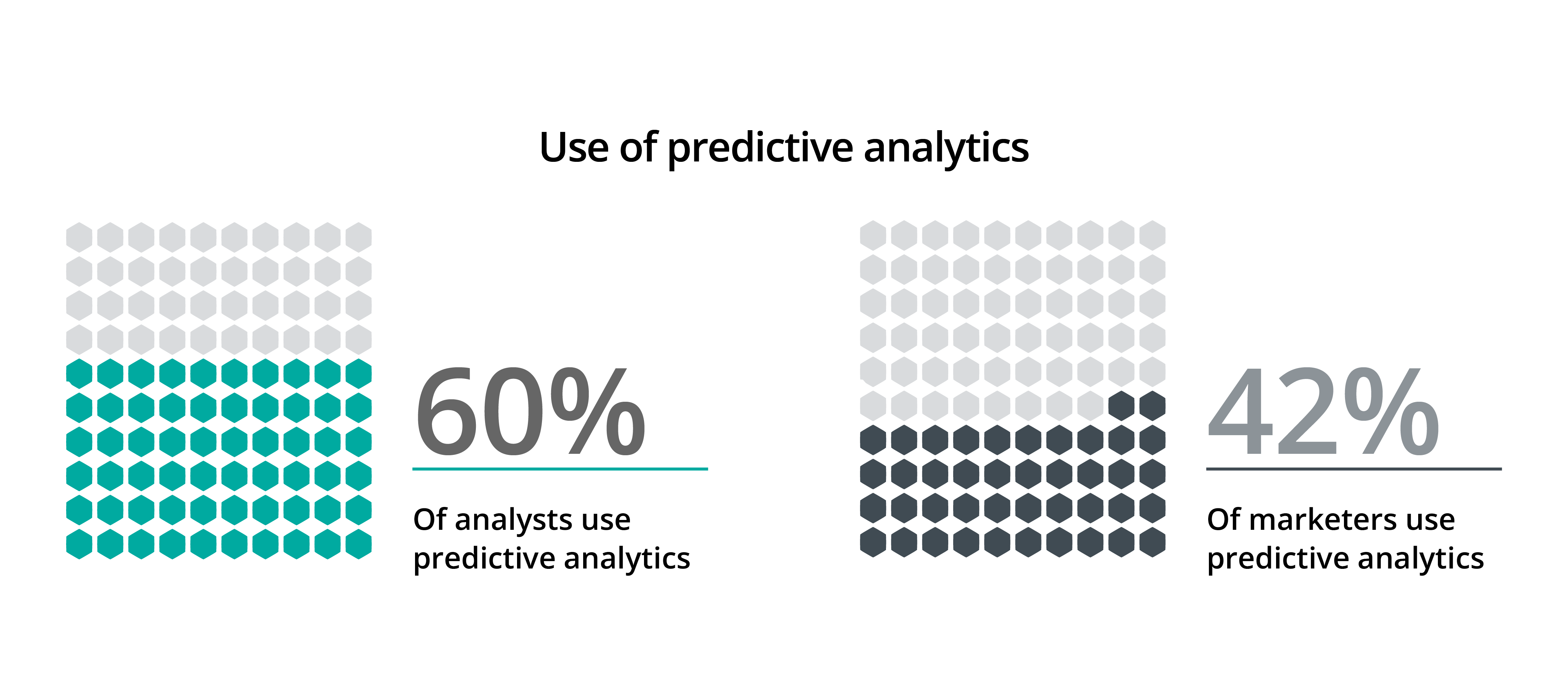
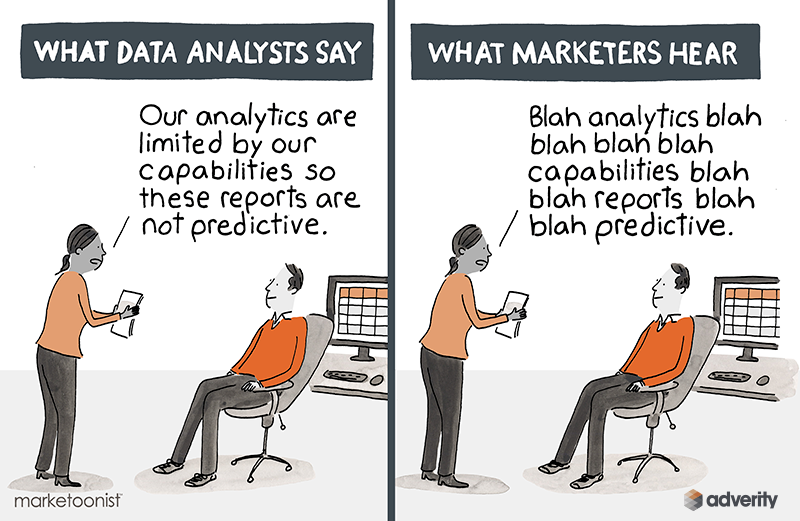
Both marketers (60%) and analysts (72%) clearly say that their departments are analytically mature and constantly looking for ways to become more advanced with their use of data. And, overall, analysts are more confident in their analytical capabilities, reflecting how close they are to the analytics process compared with marketers.

Both marketers and analysts are confident in their organizations’ analytical maturity, and say that departments are data-driven and use data to inform strategic marketing decisions. 58% of marketers and 69% of analysts agree with this. However, at the same time, 41% of analysts don’t trust their data.
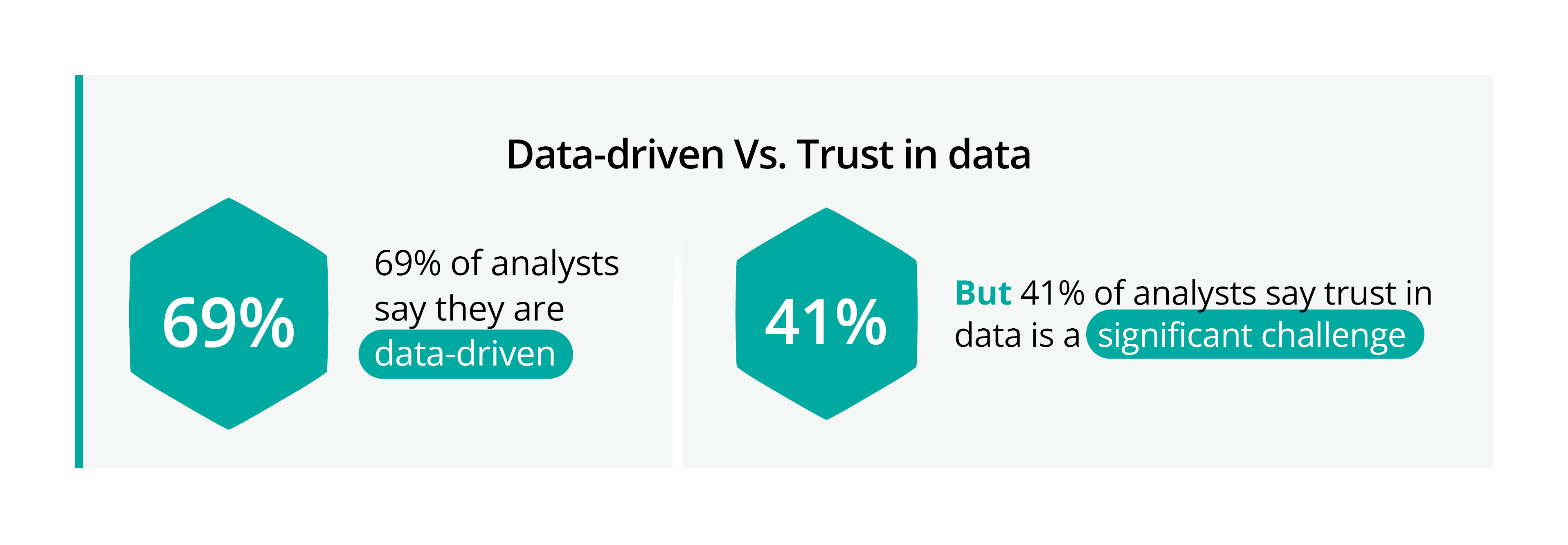
Analysts and marketers both agree that having a unified view of marketing performance and developing their predictive analytics are the priorities for the next 12 months, however, they disagree on the order.
While 69% of analysts see predictive analytics as the top focus in 2022, marketers are most keen to achieve a single unified view (58%). Again, this reflects a focus from analysts on prioritizing capability while marketers show a clear preference for usability.
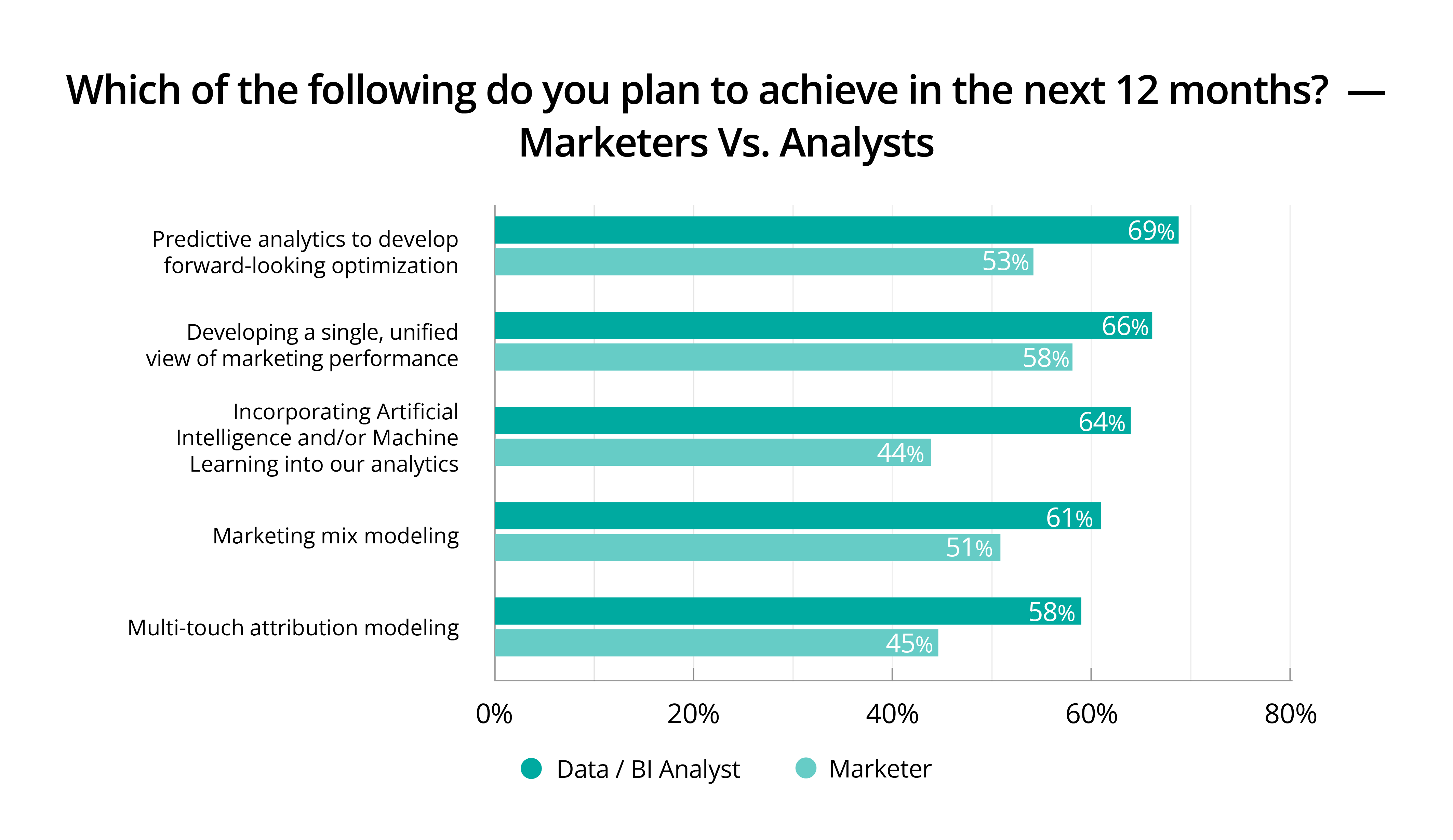
For both marketers and analysts, multi-touch attribution is the lowest priority in 2022. This reflects how cookie-deprecation and tightening data privacy rules will have an impact on the effectiveness of attribution modeling. Marketers are more decisive than analysts with more than half stating that multi-touch attribution is not on the roadmap for 2022.
64% of analysts have plans to incorporate AI into their analytics, ranking this much more highly than marketers. In fact, analysts are 20% more likely to see AI and machine learning on their 2022 roadmap than marketers, making this the biggest discrepancy. Again, this highlights a disconnect between the two roles with analysts firmly focused on improving the capability of their analytics.
While predictive analytics and AI are high on the list of priorities for analysts in 2022, their biggest challenge remains the time and effort for manual data wrangling. This highlights a disparity between a desire among analysts to improve their analytics with more sophisticated capability on the one hand, and the reality of the day-to-day challenges they face on the other. However, business leaders can support analysts by freeing them from the manual data integrations that monopolize their time and may be preventing them from delivering more advanced analytical insights.
.png?width=720&name=uk-us-de-comparison%20(1).png)
If your organization has marketing teams dotted around the world, it’s likely these teams won’t have the same strengths, priorities, or challenges. Strategies are going to differ from one area to the next, and a big reason for this is variation in data privacy laws. Respondents from Germany and the UK who must account for GDPR are much more likely to champion a strategy that doesn’t depend on cookies.
Overall, Germany lags behind the USA and UK in terms of current analytical capability, with respondents 10-15% less likely to currently have advanced capabilities. That said, Germany and the USA are the least likely to be using predictive analytics, while Brits are the least likely to have a centralized data warehouse.
Despite confidence around current analytics capabilities, the majority of marketers and analysts still use spreadsheets for building market reports. However, this is less pronounced in Germany, where less than half of marketers admit to building marketing reports in spreadsheets. This number rises to 3 out of 5 in the UK and US.
In all three countries, there are significant differences between the relative certainty of analysts and marketers; however, this is much more pronounced in the US, with German respondents the least likely to disagree. On average, German marketers are twice as likely to agree with their data analysts about their current capabilities than US marketers.
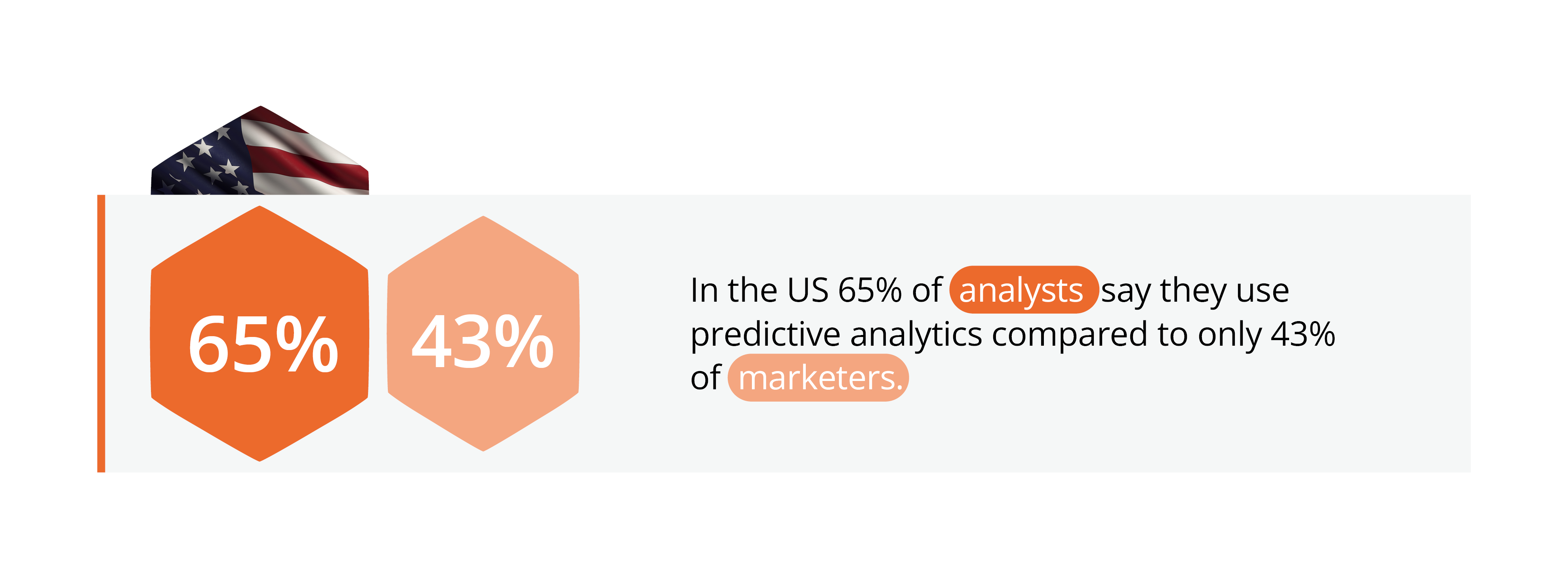
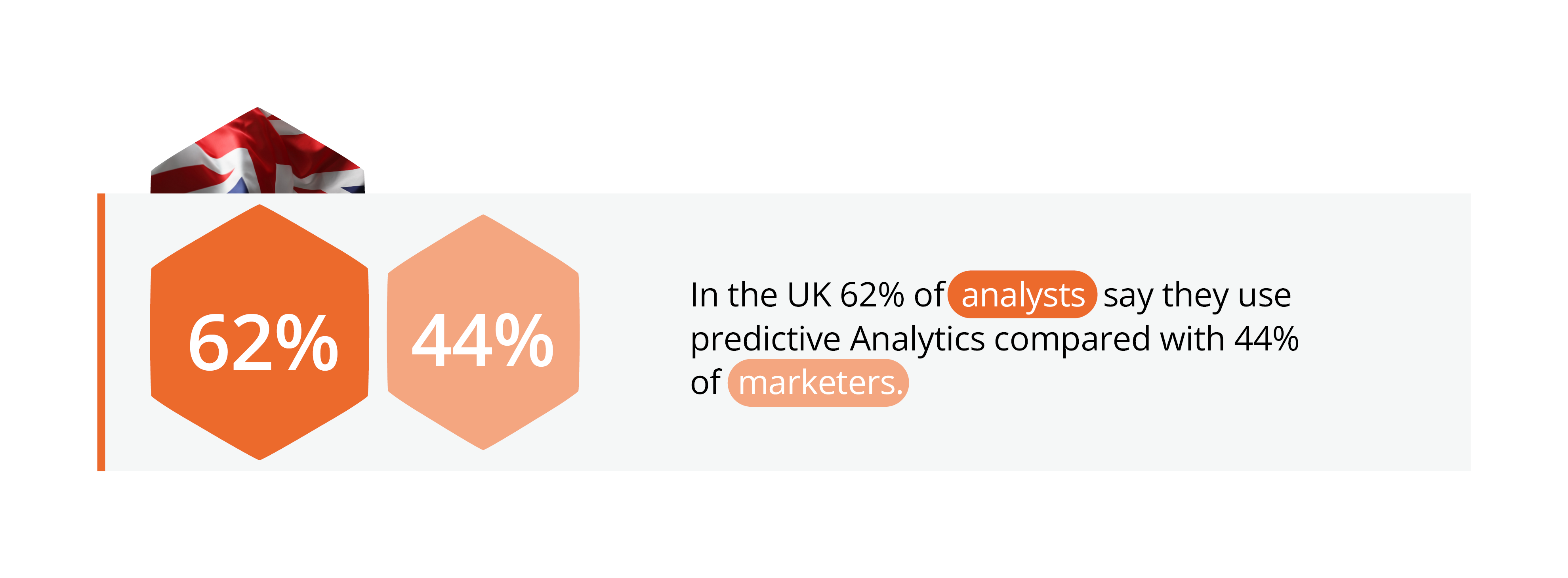
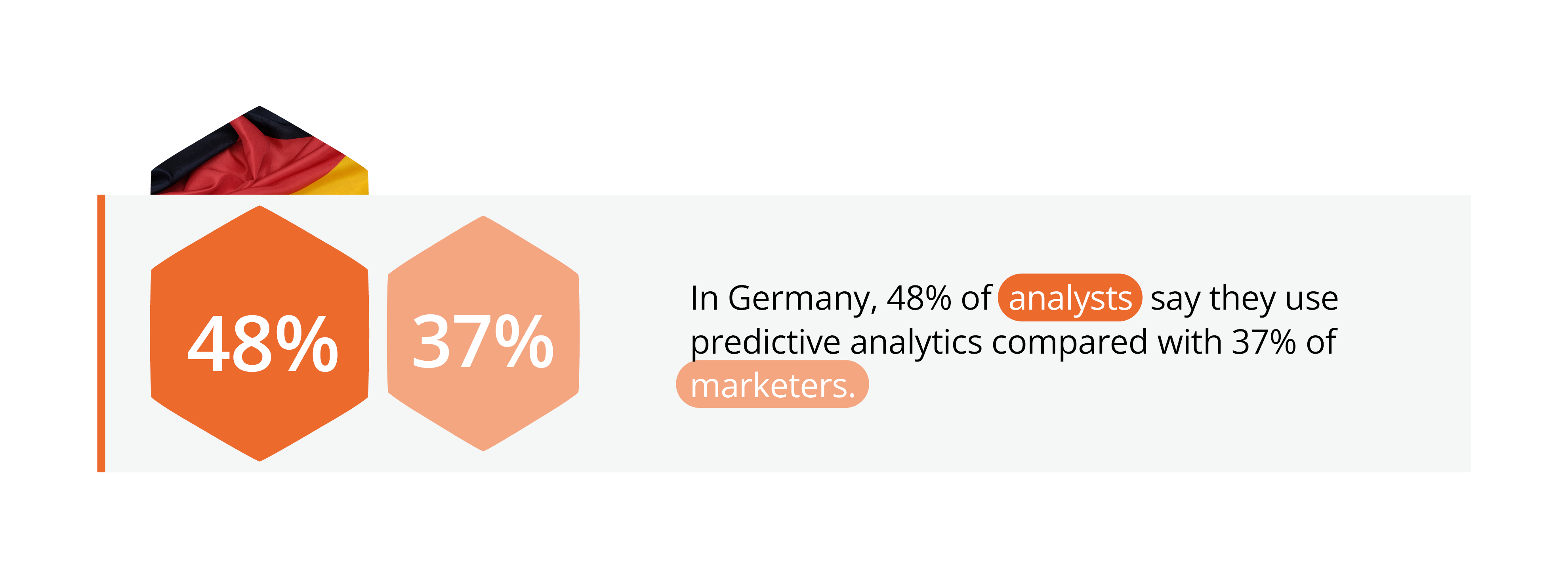
Top 5 current analytical capabilities ranked by region |
|||
| Rank | |||
| 1 |
Presentations are developed in PowerPoint / Google Slides |
Presentations are developed in PowerPoint / Google Slides | Presentations are developed in PowerPoint / Google Slides |
| 2 |
Marketing reports are typically built on spreadsheets |
Our marketing team has self-serve access to real-time reporting |
We use a Business Intelligence tool to visualize our marketing data (i.e. Tableau, Qlik, Power BI, etc.) |
| 3 |
We combine our marketing data with other departmental data to make company-wide decisions |
Our reports show end-to-end performance of marketing campaigns |
The majority of our marketing reporting is provided through a dedicated analytics / BI team |
| 4 | Our marketing team has self-serve access to real-time reporting | Marketing reports are typically built on spreadsheets | Our marketing team has self-serve access to real-time reporting |
| 5 | Our reports show end-to-end performance of marketing campaigns | We combine our marketing data with other departmental data to make company-wide decisions | PMarketing reports are typically built on spreadsheets |
US and UK marketers and analysts are highly positive about the data culture in their organization with 70% of American and 67% of British respondents believing their company is analytically mature, and constantly looking for ways to become more advanced with their use of data.
By comparison, German respondents are much less confident in their data culture, and are 15-20% less likely to agree that their company meets any of the options. In particular, only 52% of marketers in Germany believe their organization is data-driven compared to 68% of those in the US. While to some extent this is reflective of the overall cultural differences between the three nations, it also goes hand in hand with German businesses’ top priorities around getting value out of their data. That said, while German respondents ranked the ability to optimize campaigns on the fly and adjust in real-time, for the US and UK this was ranked the lowest capability.
| The % of marketers and analysts that agree or strongly agree | |
|
|
| Data-Driven: we make strategic marketing decisions based on objective data |
68% |
66% |
52% |
| Test and Learn: we regularly test hypotheses and let the results guide our marketing strategy |
67% |
60% |
54% |
| Optimize on the Fly: we closely monitor the performance of marketing campaigns and adjust in real-time |
61% |
63% |
58% |
| Analytically Mature: we are constantly looking for ways to become more advanced with our use of data |
70% |
67% |
59% |
In all three countries, the top two analytics priorities in the next 12 months are developing a single, unified view of marketing performance and leveraging predictive analytics. In this category, the responses from Germany are on a very similar level to the USA and UK, suggesting a certain amount of optimism from German marketers and analysts that they can close the gap in terms of analytical capabilities within the next 12 months.
While in Germany, analysts and marketers agree that creating a single, unified view of performance is the number one priority in 2022, in the USA and UK, data analysts disagree. For British and American analysts, predictive analytics is the main focus, with some 73% of US and 70% of UK analysts seeing forward-looking optimization as a key priority in the next 12 months, compared to just 55% and 56% of marketers respectively.
Top 5 analytics priorities in 2022 |
|||
| 1 | Predictive analytics to develop forward-looking optimization | Developing a single, unified view of marketing performance | Developing a single, unified view of marketing performance |
| 2 | Developing a single, unified view of marketing performance | Predictive analytics to develop forward-looking optimization | Predictive analytics to develop forward-looking optimization/Marketing Mix Modeling |
| 3 | Multi-touch attribution modeling | Marketing Mix Modeling | |
| 4 | Marketing Mix Modeling | Incorporating Artificial Intelligence and/or Machine Learning into our analytics | Incorporating Artificial Intelligence and/or Machine Learning into our analytics |
| 5 | Incorporating Artificial Intelligence and/or Machine Learning into our analytics | Multi-touch attribution modeling | Multi-touch attribution modeling |
In both the UK and Germany, multi-touch attribution is the lowest priority whereas in the USA this remains a relatively key strategy for 2022. This may reflect the relative strength of GDPR regulations compared to the varying legislation regulating data privacy in the USA. Consequently, both the UK and Germany rank market mix modeling, a cookie-less method of performance tracking, much higher than US marketers and data analysts.
Different industries will be focusing on different strategies for 2022. Continuously, we see that tech and eCommerce respondents are further along when it comes to advanced analytics, while telecoms and media companies are lagging behind.
On average, Tech and eCom have the most data capabilities. While tech organizations have a well-rounded suite of data capabilities, eCom tends to be more focused on the use of a BI tool, combining marketing data with other departmental data, and self-serve real-time access to marketing data.
Finance and marketing agencies are in the mid-tier of data capabilities. Both say they combine data across departments to make decisions. Finance organizations are more likely to use a BI tool, and centralized data. Marketing agencies more commonly have self-serve reporting and end-to-end marketing
Telecom and media have the fewest capabilities on average. Media tend to have more capabilities around real-time, centralized data and end-to-end reporting, while telecom is much more likely to have a BI team to deliver marketing reporting.
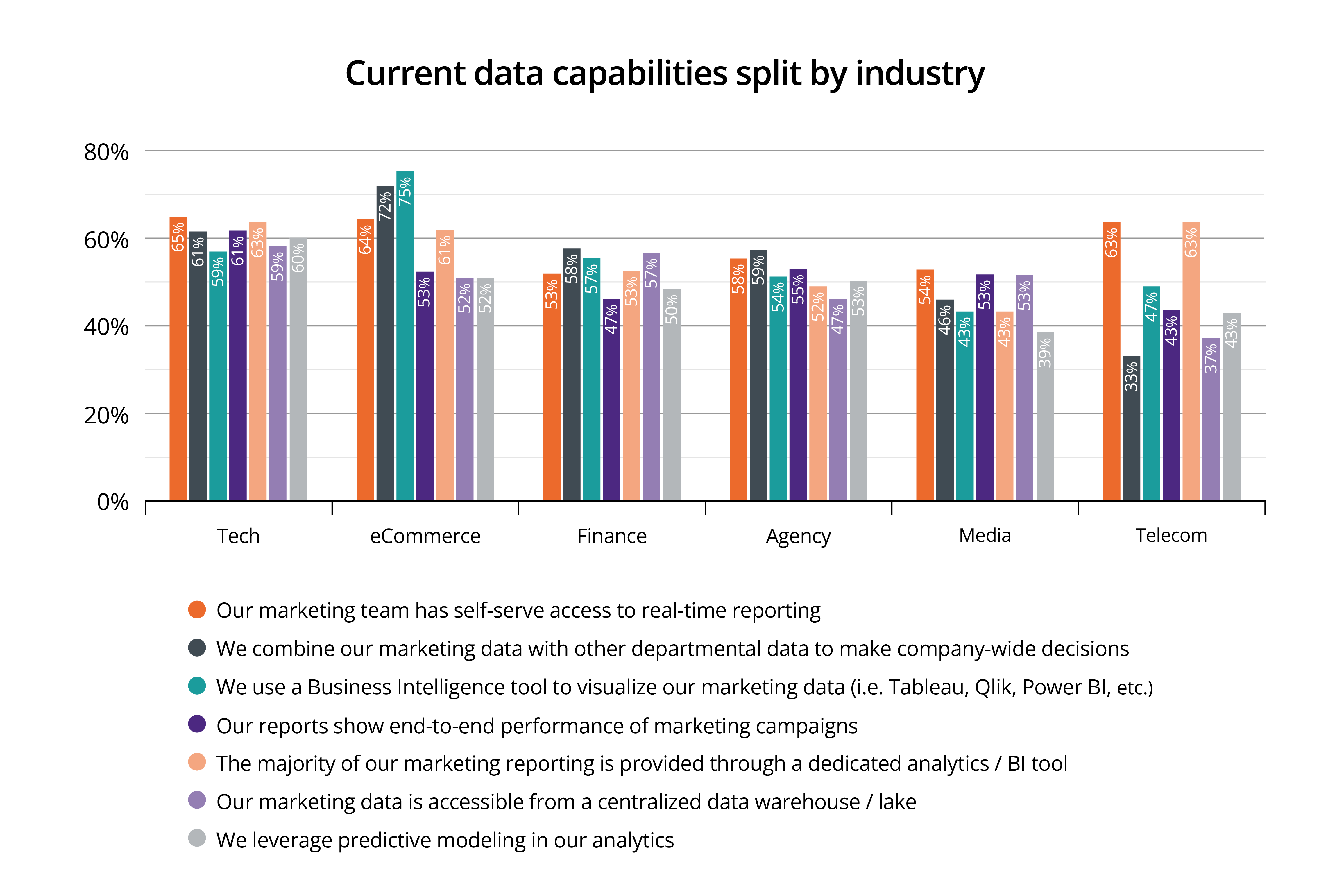
The cross-industry average tells us that creating a single unified view of marketing performance, and predictive analytics are the most common plans for 2022. Tech, eCommerce, finance, and marketing agencies all conform to this. However, media and telecom organizations have a different game plan.
After developing a single view, media companies' next most common plan for 2022 is to implement marketing mix modeling.
Telecom companies are more likely to work on their multi-touch attribution capabilities in 2022.
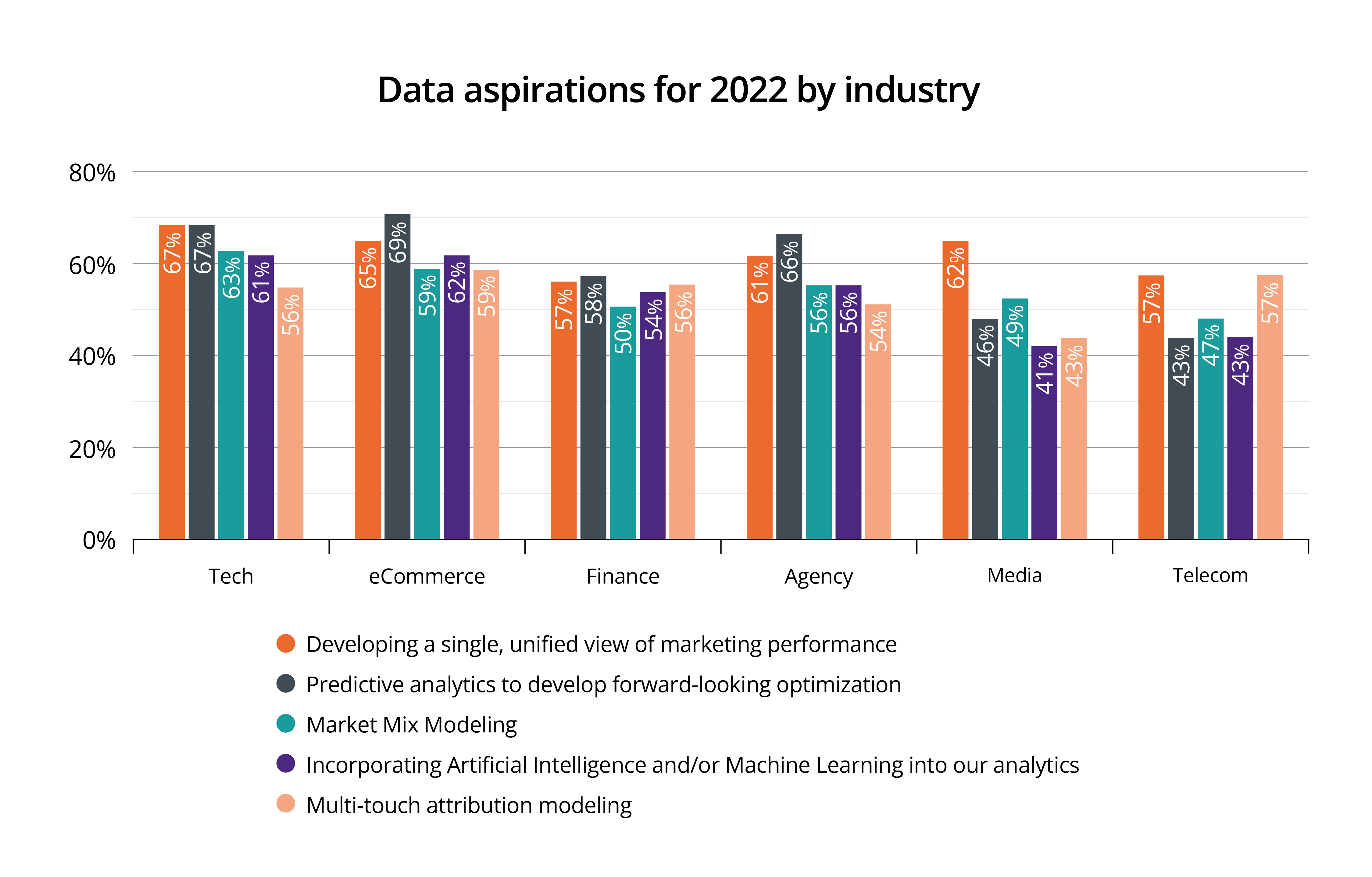
Data Analyst, Germany, Director, Automotive
In August 2021, Sirkin Research, commissioned by Adverity, surveyed 964 Marketers and Data / Business Intelligence Analysts across the United States, United Kingdom, and Germany about Marketing Analytics. The survey covered topics ranging from current capabilities, key challenges, and strategic priorities of organizations’ use of marketing data and analytical maturity. Respondents represented a large range of industries, including Technology, Marketing Agencies, and eCommerce.
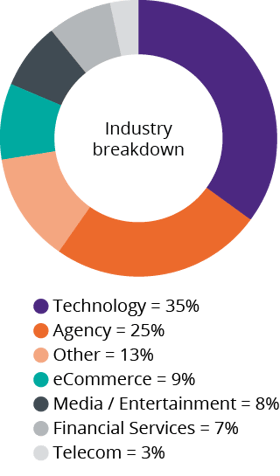
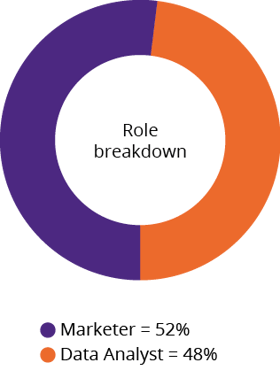
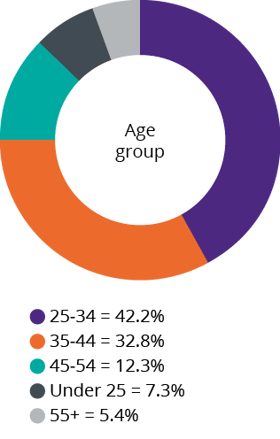
Sirkin Research is the leading custom research service for B2B marketers. They have spent the last 15 years working with some of the fastest-growing marketing, technology and financial brands in the world, from Copenhagen to London to New York City, helping them understand and generate demand from their audience, based on hyper-relevant, data-driven insight.